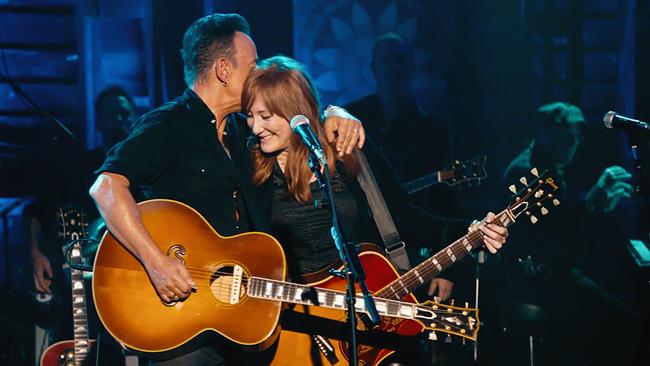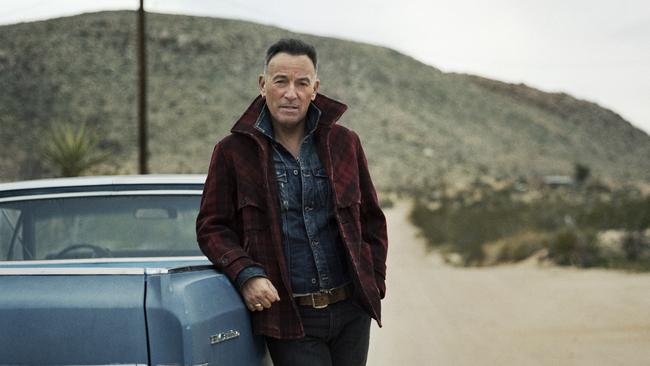Bruce Springsteen’s hungry heart on show in Western Stars
Bruce Springsteen, 70, opens up about his destructive personality, fear of failure and the two sides of the American character.

The radio is blaring as I drive, lost in thought, down a remote country road in Puglia in southern Italy. A strings-swept track soars through the car. It clutches my throat and reduces me to tears. I spend days afterwards in a Googling frenzy attempting to ID the song, finally revealing it to be There Goes My Miracle, the second single from Western Stars, Bruce Springsteen’s first solo studio album in five years. The Boss has brought me to tears.
Weeks later, it feels like “pinch me-I’m-dreaming” serendipity to find myself in London’s uber-chic Soho House Hotel on a chilly Saturday morning, having been invited by The Boss to a special screening of Western Stars, the film of the same name, and to hear him chat with his long-time cinematic collaborator, Thom Zimny, about its making.
Springsteen, in trademark checked shirt, battered jeans and cowboy boots, has recently turned 70, looks fit, tanned and much younger than his years. When he walks to his chair on the small stage however, the steel grey in his buzz-cut glints and there’s just the teeniest hint of age in his gait.
Much of the movie, he says, was shot in the enormous, cathedral-like barn that sits on the family ranch in Colts Neck, New Jersey: “The barn is pretty cool. You know, it just came with the property and we rebuilt the bottom for the horses and upstairs hasn’t been touched since the late 1800s. So, all that has been there for a hundred years.
“You walk into that upstairs and it’s just an incredible space … we have our parties and weddings and we built that little bar … all that’s up there (is) not just for the film. That’s actually how we keep it. So, it’s kind of neat.”
Unlike the album, released in June, the barn concert is performed with Patti Scialfa, his wife of 30 years, playing guitar by his side. Springsteen says there were only two rehearsals — one in New York and one on the ranch – and they filmed all 13 tracks inside two days. It seems a hell of a feat considering they’re accompanied by a 30-piece orchestra he’d never met.
And yet the film is imbued with a palpable intimacy and an almost confessional tone. Springsteen himself describes it as a kind of “musical meditation”, musings on men and women, on love, on loss, on the mistakes we all make – and the regrets that follow.

There is a particularly unforgettable moment during the track titled Stones when Springsteen leans in towards his wife and with foreheads touching, they look at each other and sing: “I woke up this morning, with stones in my mouth. You said those were only the lies you’ve told me; those were only the lies you’ve told me.”
“I should have had Patti on the record … you know that was a big mistake,” he says almost wistfully after the screening.
“Because it’s all about men and women and Patti brings so much and we’ve been together for such a long time, for 30 years, and so that’s a lot of experience around that one little microphone, so we bring all that the minute we lean in.
“Oh, my lord, there’s this whole 30 years of emotional life together between us. She’s wonderful and, really, her presence even when she’s not singing with me … if you dig deep down into the centre of the film, she’s there.”
Springsteen started writing Western Stars in 2012, “put it away” for a couple of years then went back to it, editing the 40 songs he’d put down to 12 for the album. (A 13th song, an impromptu, joyful rendition of Rhinestone Cowboy winds up on the film but was captured only because a cameraman, fortuitously, kept filming after it was all supposed to end.)
Originally, Springsteen had decided that instead of touring the album, he’d simply film it all, from start to finish. But almost immediately after the shoot, both artist and director felt this approach wasn’t enough, and Springsteen began to ponder how best he could “get people into the inner life of these songs they’ve never really heard before”.
Initially, they recorded interviews with Springsteen talking about each song but once again, that just didn’t feel right.
“Then, one night, in front of the television, I was sitting there and I just kind of started to scribble my thoughts down for each song. And it was all right there. So, I ended up with the script that is the voiceover,” he says.
The film’s spoken introduction, delivered in the drawling gravel of the man born to run, brings together the perennial existential tensions he perceives in himself and between the “two sides of the American character … the struggle between individual freedom and communal life”, he says.

Each song tells its own cinematic story, the many characters playing out the “two impulses that run against each other”. He sings of the drifter hitchhiker, the busted-up stuntman, of unending restlessness, homesickness, the ache of lost love and the riotous happiness and optimism of youth.
In the end, while the film is interspersed with sweeping, drone shots of galloping mustangs, the vast California desert and wide endless skies over Joshua Tree, it is also imbued with an introspective biographical quality thanks to long, facial close-ups and a wonderful smattering of family home movies, including several poignant, affectionate moments between a youthful Springsteen and Scialfa kissing outside the remote log cabin where they spent their honeymoon.
“If you look at the films that Thom chose it’s all ritual, ritual, ritual, ritual. The things that connect us, you know, weddings, parties, family, dancing, the things that keep our heads above water,” he says.
Within the film’s narrative, he is even more contemplative: “It’s easy to lose yourself or never to find yourself, the older you get the heavier that baggage becomes that you haven’t sorted through. So you run,” he twangs.
“And I’ve done a lot of that kind of running. I’ve spent 35 years trying to learn how to let go of the destructive parts of my character and I still have days when I struggle — we all have our broken pieces, emotionally, spiritually. In this life nobody gets away unhurt.”
Springsteen’s love of American directorial greats like John Ford is evident in Western Stars. Zimny, who is billed as co-director, says the artist was brimming with ideas for the film and contributed much more than performance and musical content, even suggesting the final, poignant shot of his wife’s hand closing over his own.
Says Springsteen: “When I write in character, in other words, I’m writing these narrative short stories … you know, it’s a way of exposing your own inner life and struggles but you’re (also) writing all the details of someone else’s life.
“I tend to write real cinematically when I do that — whether it’s Nebraska or The Ghost of Tom Joad or Devils & Dust — those are all my short story records … really, they’re my little movies that I script out before. And so, those songs are always suggestive of a visual landscape.”
For Springsteen, Western Stars comprises part three of what he sees as a bigger, later-life oeuvre – a trilogy that began with his 2016 memoir, Born to Run and was followed by the critically acclaimed Springsteen on Broadway show, his artist’s residency at the Walter Kerr Theatre in New York where he performed over 236 nights grossing $US113m ($166m) in the process. Now he’s getting to the age when “you’re summing up a lot of what you’ve learned and what your life has been”.
“I’ve had a really, really good run over the past five years as far as feeling really inspired and being really creative. I’ve done things I’ve never done before. It’s been, I feel, very lucky for that because you never know.”
Watching Springsteen talk with such energy about his life’s work makes it seem anathema that he’d suffer tremors of self-doubt. And yet, like most artists, he too fears the drying up of creativity. “I just hope I can write something because you always think you’re never gonna write again. Because you can’t explain writing. Writing is a mystery. Anything creative remains a mystery,” he says.
“Am I gonna ever write another song? Because you often think ‘I have no ideas’. I’m simply wandering around for a year without any ideas or any inspiration and so suddenly something comes along and you find another vein in your creative mind that you can tap.”
For this album, the vein lay in Southern California, in Burt Bacharach and Jimmy Webb, and writing with major seventh chords, something he’d never done before. “The hardest thing to do is write rock music because I’ve written a lot of it … that’s always the challenge as you get older. I always say your audience wants you to do two things: they want to feel at home and they say ‘surprise me’ – what you have to do (is) those two things at the same time.”
Springsteen says he feels lucky to have such a huge audience worldwide that continue to support his work year after year: “I don’t ever take it for granted, it’s a wonderful thing.
“What do I want (for the film’s audience)? Well, to come in and see it. And you’re with your gal and you sit down and you’re watching it and then, as it gets towards the end, you hold hands.”
After the screening, I can’t resist but mention to Springsteen the car-blubbering story. “The only other music that has made me cry is Mozart,” I blurt out.
With that, he takes both my hands, squeezes them, grinning ear to ear, and says: “Well, I’m in good company then.”
Western Stars opens on December 4.



To join the conversation, please log in. Don't have an account? Register
Join the conversation, you are commenting as Logout